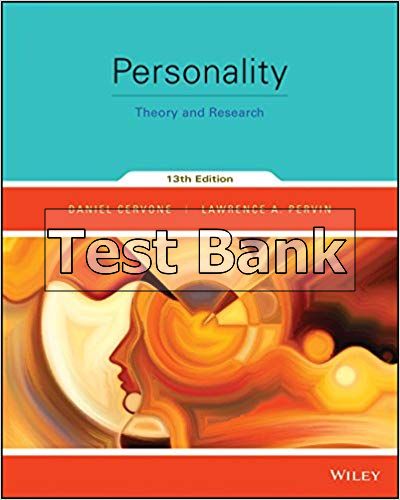Test Bank For Personality Theory And Research By Daniel Cervone 13th Edition
Digital item No Waiting Time Instant DownloadISBN-13: 978-1118976296 ISBN-10: 9781118976296
In Stock
Original price was: $85.00.$28.00Current price is: $28.00.
Test Bank For Personality Theory And Research By Daniel Cervone 13th Edition
Chapter: Chapter 03: A Psychodynamic Theory: Freud’s Psychoanalytic Theory of Personality
Multiple Choice
- 1. An early influence on the development of Freud’s process model of dynamic functioning was
- a. Brucke’s physiological model.
- b. Einstein’s physics model.
- c. Charcot’s model for hysteria.
- d. all of the above.
Ans: a
-
- 2. The 19th-century movement which argued that natural science principles could explain all human biological and psychological functioning was called
- a. psychoanalysis.
- b. mechanism.
- c. hypnotism.
- d. catharsis.
Ans: b
-
- 3. Various factors affected Freud’s theory. Which of the following is not one of these influences?
- a. Victorian era.
- b. World War I.
- c. academic psychology.
- d. anti-semitism.
Ans: c
-
- 4. Which of the following is an important component of the Freudian view of the person?
- a. energy system.
- b. pleasure principle.
- c. both (a) and (b).
- d. neither (a) nor (b).
Ans: c
-
- 5. Which concept expresses a release of emotion following talking about one’s problems?
- a. catharsis.
- b. free association.
- c. transference neurosis.
- d. dream interpretation.
Ans: a
-
- 6. Freud sees society as
- a. frustrating a person’s basic desires.
- b. necessary for happiness.
- c. prohibiting any gratification.
- d. conflicting with demands of the ego.
Ans: a
-
- 7. At the heart of the psychoanalytic view of the person is that the person is
- a. a scientist.
- b. a computer.
- c. basically like other species.
- d. an energy system.
Ans: d
-
- 8. Voon et al. (2010) used fMRI to track the brain activation of people with and without conversion disorder. What results would have supported the idea that people with conversion disorder are likely faking their symptoms?
- a. similar strength of connection between regions associated with emotion and motor movement between the two groups
- b. the same pattern of brain activity in response to emotional faces
- c. different strength of connection between regions associated with emotion and motor movement between the two groups
- d. a and c are correct
Ans: d
-
- 9. Voon et al. (2010) used fMRI to track the brain activation of people with and without conversion disorder. What results would Freud have predicted?
- a. similar strength of connection between regions associated with emotion and motor movement between the two groups
- b. the same pattern of brain activity in response to emotional faces
- c. different strength of connection between regions associated with emotion and motor movement between the two groups
- d. a and c are correct
Ans: c
-
- 10. Using fMRI, Voon et al. (2010) found that individuals with conversion disorder had a stronger connection between the regions of the brain associated with emotion and those associated with motor movement. How does this help us to understand the disorder?
- a. The emotions of people with conversion disorder interfere with their ability to control movement
- b. People with conversion disorder are much more emotional in general
- c. The emotions of people with conversion disorder interfere with their ability to control thinking
- d. People with conversion disorder get overly upset because of their symptoms


Reviews
There are no reviews yet.